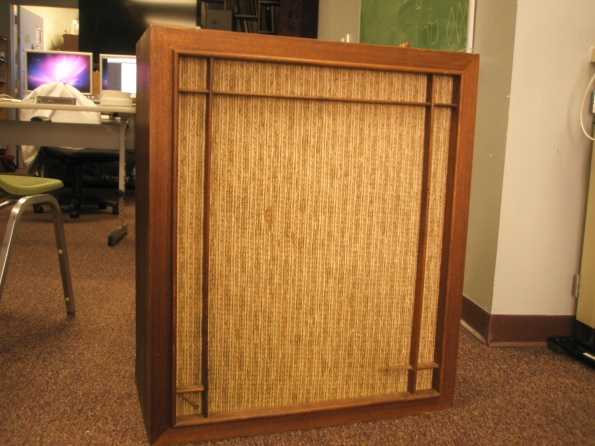Archive
Rocky Mountain 2-Way
- The Life That I Have Been Waiting For
Rocky Mountain 2-Way Loudspeaker System
Overview:
The Rocky Mountain 2-Way Loudspeaker System was designed to be used as mixing monitors.
Features:
Flat Frequency Response (1.5dB variation)
Sealed Box Construction Providing Accurate Low Frequency Reproduction
Low Frequency Extension: F3= 55Hz, F6= 45Hz, F10= 40Hz
Active Crossover With Computer Controlled DSP that allows for the maximum control of the speaker system
Absorbent Foam Baffle that combats MF Diffraction and Makes the HF more directional.
Capable of 90-98dB Continuous, 110-115 Peak
1 1/4” Cabinet Construction (13ply Baltic Birch/MDF Composite)
2 1/4 Cubic Foot Volume
Custom Made Grill
Made Proudly In Michigan
Drivers
Woofer: Seas Prestige 10″ H1411
Tweeter: Seas Prestige 27TDFC, 1″ Silk Dome Tweeter
Enclosure
Exterior: 3/4″ 13-ply Baltic Birch
Interior: 1/2″ MDF
Documents:
Design Proposal
Drafting Plans
Glossy
Final Testing Report
Block Diagram:
Testing Results:

Rocky Mountain 2-Way Loudspeaker System by Kenneth G. Stahl III is licensed under a Creative Commons Attribution-ShareAlike 3.0 Unported License.
Based on a work at kennystahlrock.com.
Wharfdale W90 project
Wharfdale W90 project
This project was intended to refurbish a set of Wharfdale W90 “six” way speakers. These speakers were old, had poor frequency extension, a lot of distortion, and a frequency response curve that looked as if a pice of spaghetti had been thrown at the spl chart. Despite this there was some unique concepts that went in to the design of these speakers originally and to be honist studying the designs of this old set of hi-fi speakers was more educational that building the speakers themselves. These speakers featured a rear baffle that was filled with sand in between two layers of wood this clever dampening design if implemented more fully though out the cabinet design process could be a useful tool in making enclosures that are both ridged and dampened. The 12 inch woofers had a unique design as well. Each cab used two woofers in a separate enclosure. This was done for the purpose of tuning one of the enclosures differently. To achieve this Wharfdale filled one of the cones with Styrofoam, this changed the moving mass of the piston (the cone of the driver) it also decreased the surface area. I suspect that this was done to even out the low end frequency response by filling in gaps that the normal woofer had ether in the low end or the high end of its range. these speakers also had a strange mid range and tweeter design. The tweeter and mid range drivers were not placed in a sealed enclosure as most cone mid range drivers and tweeters are rather they were placed in an open box(see pics below). this open box design created a lot of positive and negative summation due to the reflections off of the rear baffle and the sides and tops of the box. these reflections were severely detrimental to the frequency response and over all clarity. After the speakers had been finished I ran in to the same problem; how ever it was nearly as dramatic as in the original design. Due to the fact that cloth dome tweeters and mid range drivers were selected only the reflections off of the sides of the boxes that caused summation issues. I plan to experiment with this later to see how much moving the front baffle forward improves the frequency response. There is no doubt in my mind that the amplitude of summation is directly related to the depth of the open box. Over all the goal of improving the quality of these speakers was accomplished; the frequency response was improved and the F3 was increased to about 70 Hz from an original extension of about 100 Hz. However the comb filtering effect caused by the cab design makes these speakers sound boxy and dated. In the end these vintage Hi-Fi cabs retained a vintage tone but with greater detail and frequency extension while having flatter frequency response.
Initial Testing
 Original Frequency Response At 0 Degrees and 3 Feet.
Original Frequency Response At 0 Degrees and 3 Feet.
 The Tweeter and The Mid They Could Not Be Tested Alone
The Tweeter and The Mid They Could Not Be Tested Alone
Testing
the full system at 0, 15, 30, 45, and 60 degrees offset
Left right comparison
 Vertical off axis at 0, 15, 30, 45, and 60 degrees
Vertical off axis at 0, 15, 30, 45, and 60 degrees
 Ful system Harmonic distortion percentage
Ful system Harmonic distortion percentage
Full system Waterfall
 Tweeter offset at 0, 15, 30, 45, 60 degrees
Tweeter offset at 0, 15, 30, 45, 60 degrees
 Tweeter Vertical At 0, 15, 30, 45, and 60 Degrees
Tweeter Vertical At 0, 15, 30, 45, and 60 Degrees
Tweeter Total Harmonic Distortion
 Mid At 0, 15, 30, 45, 60 degrees offset
Mid At 0, 15, 30, 45, 60 degrees offset
 Mid Vertical Off Axis Response
Mid Vertical Off Axis Response
 Woofer At 0, 15, 30, 45, ND 60 Degrees offset
Woofer At 0, 15, 30, 45, ND 60 Degrees offset
 Woofer Verticle Offset At 0, 15, 30, 45, and 60 Degrees
Woofer Verticle Offset At 0, 15, 30, 45, and 60 Degrees








































